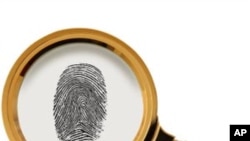In 2009, a Chinese woman illegally entered Japan by altering her fingerprints in order to fool immigration officials.
While it was Japan's first documented case of biometric fraud, disguising fingerprints to hide complicity in a crime, or to evade immigration restrictions, is on the rise worldwide.
Researchers at Michigan State University have created a way to help law enforcement officials quickly identify altered fingerprints: a precise algorithm which helps software systems identify altered prints.
Altered state
Biting the pads off fingertips or surgically replacing the fingerprints with toe prints might seem like drastic measures but Anil Jain, a biometrics expert and professor at Michigan State University, says these efforts at deception are becoming increasingly common.
“People who go through this process, which can be both expensive and painful, would want to do this only for high-valued scenarios and not for cashing a check for $50," Jain says. "So the most common uses of this fingerprint alteration is people who are seeking asylum in the United States or in Europe, because if they have a prior criminal record, they will probably not be granted asylum.”
Popular crime dramas lead many to believe it's easy to confirm a person's identity from a fingerprint. In reality, it's not so simple. A number of factors make identification difficult: whether information has been entered into a specific database, if the specimen is smudged or a partial print, and if that print has been altered.
An app for that
Very little research has been done in this last category. Existing software can alert law enforcement if the print image quality is poor. But that isn't much help because many altered prints are of good quality.
Jain's graduate student, Soweon Yoon, was part of a team that designed a precise algorithm that helps software systems identify altered prints.
“The most important feature for fingerprint matching is called minutiae. So minutiae refers to [a] ridge ending point and [a] ridge bifurcation point," Yoon says. "From typical fingerprint impression, we can extract 100 minutiae per each finger.”
While patterns on most of our fingers flow in curves and loops, those who have altered fingerprints have abrupt, discontinued lines. That generates an unusually high number of minutiae points.
“You can imagine if someone makes a cut here, they will generate a lot of ridge ending points, so that generates [an] excessive number of minutiae,” Yoon says.
While it may seem easy enough to look at a set of fingerprints and tell if it has been altered, Jain says it’s not practical.
“Some of these databases are extremely, extremely large. So the FBI database is an example, has about 70 million subjects. That means there are 700 million fingerprint images if each person has 10 fingers. And so there is no way anybody could manually check whether there are altered fingerprints or not.”
Eliminating the guesswork
As it analyzes images, the application does not identify people, it simply alerts officials to an anomaly, so they can perform a secondary inspection. And, Jain says, it also takes the guesswork out of determining whether or not a print has been altered.
“Different human experts will have different degrees of proficiency in identifying (prints), and they get tired and so their decisions are not necessarily going to be consistent. Whereas a computer algorithm is going to be consistently behaving, there is no subjectivity in it once you tune it, it’s going to behave in the same way.”
The application also helps distinguish between accidental and intentional alterations. Most accidents result in scars on only a few fingers. If there are changes in five or more, that was most likely done on purpose.
The methods for altering fingerprints are becoming more sophisticated every day. Back in 1934, the infamous American bank robber John Dillinger burned his fingers with acid, hoping to evade identification and capture.
According to Yoon, today's criminals use everything from making a Z-shaped cut on the finger pad and switching the skin flaps, to creating temporary silicon overlays, and even triple print switches.
“Recently, three people were charged because of this fingerprint alteration. So one was the patient who received a surgery and then the second one was the broker, and the third one was the physician who performed that surgery.”
Michigan State University has licensed the new application to Morpho, a leading biometrics identification firm based in Paris. The company, which supplies software systems to many of the world's top law enforcement agencies, expects it will be able to market the application easily and quickly.
Meanwhile, Jain and his team are developing algorithms and software, which will one day be able to recover and rebuild fingerprints from altered samples.






